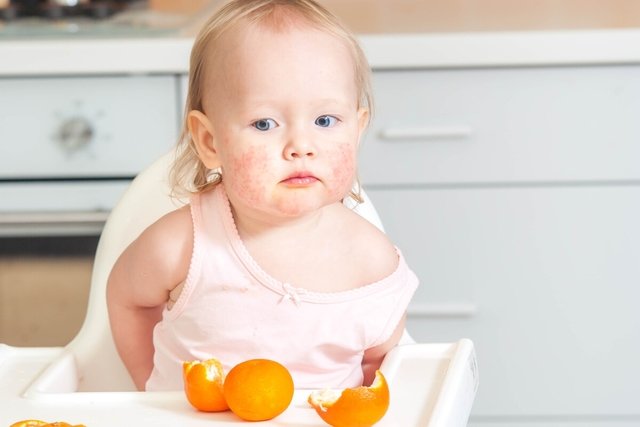Food allergy in babies is an immune system reaction that can cause symptoms such as red spots on the skin, itching, swelling in parts of the body or diarrhea after eating specific foods.
This exaggerated reaction of the immune system is more common in babies after ingesting foods such as milk and/or dairy products, eggs, fish or soy and, sometimes, may be related to the foods the mother consumes.
If you suspect a food allergy in your baby, it is recommended to consult a pediatric allergist or pediatrician. Treatment typically involves avoiding the foods that trigger allergy symptoms.

Symptoms of food allergies in babies
The main symptoms of food allergies in babies:
- Reddish spots on the skin;
- Itching on the body;
- Runny or stuffy nose;
- Abdominal pain, vomiting and/or diarrhea;
- Blood and/or mucus in the stool;
- Swelling in parts of the body, such as the tongue, lips and face;
- Coughing and wheezing and/or difficulty breathing.
Food allergy symptoms in babies tend to appear a few minutes to a few hours after eating the food and, in the case of symptoms such as drowsiness, weakness or a racing heart, they may indicate a serious allergic reaction such as anaphylaxis. See more symptoms of anaphylaxis.
Online symptom test
To find out the chances of your baby having an allergy, please select the symptoms you are experiencing:
This test is just a guidance tool. Therefore, it is not intended to provide a diagnosis or replace consultation with an allergist, immunologist or pediatrician.
How to confirm the diagnosis
The diagnosis of food allergy in a baby is made by a pediatric allergist or pediatrician taking into account the symptoms presented and, sometimes, the results of allergy tests, such as the RAST or prick test. Discover the main allergy tests.
If you want to make an appointment, you can find the pediatric allergist closest to you using the tool below:
Taking care of your health has never been easier!
If you suspect a food allergy in your baby, it is important to be aware of which foods may be causing the symptoms. Especially in exclusively breastfed babies, the cause of the allergy may be present in the mother’s diet.
Possible causes
Most of the time, food allergies in babies are caused by the ingestion of cow’s milk or dairy products, eggs, wheat and/or soy-based foods, nuts, peanuts, fish or seafood by the baby or mother, if the baby is still breastfed.
The main food consumed by women and which can be passed into breast milk for the baby causing allergies is cow’s milk. In this case, the mother may be advised to replace this food with other sources of calcium. Check out a list of foods rich in calcium.
How the treatment is carried out
The best way to treat food allergies in babies is to avoid giving foods that cause symptoms, in accordance with the advice of the pediatric allergist. If the baby is still breastfed, it is also recommended that the mother avoid the same foods.
Sometimes, your doctor may recommend the use of anti-allergy medications to alleviate symptoms if they arise. However, in the case of severe allergic reactions, treatment may need to be carried out in the hospital and involve the injection of epinephrine and/or the use of medication directly into the vein.
In some cases, the child spontaneously becomes tolerant to the food they are allergic to until the age of 6, so that when they consume the food again, they may not develop allergy symptoms.
What to do to avoid food allergies
To avoid food allergies in your baby, you must:
- Correctly follow the pediatrician’s instructions regarding nutrition;
- If possible, continue breastfeeding until 6 months and, ideally, until 2 years;
- Do not give solid foods to your baby before 6 months;
- Avoid cow’s milk in the first year of life.
Furthermore, it is important that the food responsible for the allergy is identified, as this makes it possible to avoid the consumption of this food by both the mother and the baby, if the introduction of food has already started.
Bibliography
- STATPEARLS. Food Allergies. 2023. Available at: <https://www.ncbi.nlm.nih.gov/books/NBK482187/>. Accessed on January 12, 2024
- JOHNS HOPKINS MEDICINE. Food Allergies in Children. Disponível em: <https://www.hopkinsmedicine.org/health/conditions-and-diseases/food-allergies-in-children>. Acesso em 12 jan 2024
- ELGHOUDI, Ahmed; NARCHI, Hassib. Food allergy in children—the current status and the way forward. World J Clin Pediatr. Vol.11, n.3. 253–269, 2022
- SILVA, Amanda Maria L.; MONTEIRO, Gicely Regina S.; TAVARES, Adrienny NS; PEDROSA, Zenaide Verônica R. Early food introduction and the risk of allergies: Literature review. Global Nursing. Vol 54. 485-498, 2019
- BRAZILIAN SOCIETY OF PEDIATRICS. food allergy. 2014. Available at: <https://www.sbp.com.br/fileadmin/user_upload/2015/02/Texto_Alergia_Alimentar_Portal_SBP_2014.pdf>. Accessed on 30 Dec 2021

Sign up for our newsletter and stay up to date with exclusive news
that can transform your routine!
Warning: Undefined array key "title" in /home/storelat/public_html/wp-content/plugins/link-whisper-premium/templates/frontend/related-posts.php on line 12
Warning: Undefined array key "title_tag" in /home/storelat/public_html/wp-content/plugins/link-whisper-premium/templates/frontend/related-posts.php on line 13



